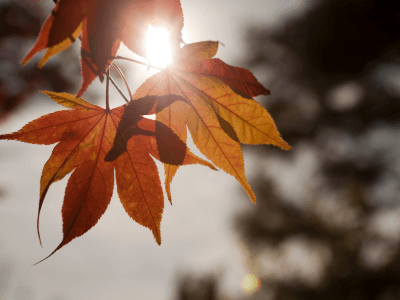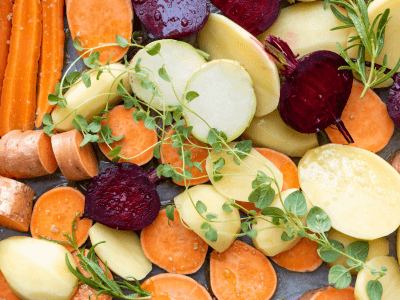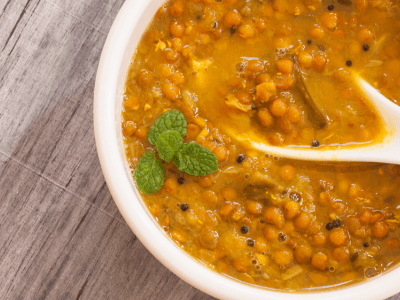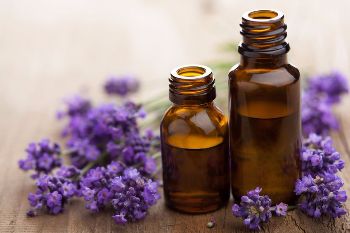Dr. Rachel Stricker Blog
Nourishing Your Body This Fall: An Ayurvedic Perspective
ggg

As the crisp air of autumn sets in, Ayurveda reminds us that this season is dominated by Vata dosha—the energy of air and ether (space).
Ayurveda is the traditional system of medicine from India that views health as a balance between body, mind, spirit and the rhythms of nature. At its foundation are the three doshas—Vata, Pitta, and Kapha, which are bio-energetic forces formed by the five elements (earth, water, fire, air, and ether/space). Each person has a unique constitution, but all three doshas are present and shift with time, lifestyle and the seasons.
Autumn is considered the Vata season because the environment mirrors Vata’s qualities: cool winds, dryness, irregular temperatures, and increased mobility. This, in turn, can aggravate Vata in the body. Vata governs movement, circulation, breath, and the nervous system. When the Vata constitution becomes imbalanced, it can manifest as physical dryness which can show up as dry skin and hair or achiness in the joints. Because it is ruled by the air element, imbalances can also show up in the digestive system as bloat, gas, and constipation. Mentally, imbalance can show up as anxiety, insomnia, restlessness, dizziness, scattered thoughts, agitation, fidgeting, and a general feeling of ungroundedness. When Vata is balanced, it manifests as energy, creativity, and enthusiasm.

Balancing Vata in Autumn
Ayurveda teaches us that balance comes from applying opposite qualities. For Vata, this means:
- Warmth: Favoring warm foods, drinks, and environments.
- Moisture: Consuming healthy oils (ghee, sesame, olive oil) in the diet, doing an oil self-massage, and staying hydrated.
- Grounding: Sticking to regular routines, nourishing meals, and calming practices.
- Stillness: Balancing activity with rest, meditation, and slow breathing.
By embracing these practices, we align with nature’s cycles and keep Vata harmonious during the autumn season—supporting energy, digestion, and emotional steadiness.

Practical Tips for Vata Season
1. Consume a Nourishing Diet
- Favor warm, cooked meals like soups, stews, and porridges.
- Include healthy fats in your diet to combat dryness.
- Consume grounding vegetables like carrots, sweet potatoes, squash, and beets.
- Reduce raw salads, cold drinks, and overly dry foods (crackers, chips).
- The main Vata tastes are sweet, sour, and salty, so a drizzle of maple syrup, a squeeze of lemon or lime, and a pinch of mineral salt are generally welcomed additions.
2. Strive for Daily Routine
- Maintain a regular sleep, rest and meal schedule to stabilize Vata’s tendency toward irregularity. Ideally, going to bed by 10 p.m. and waking by 7 a.m. Don’t overbook yourself and allow moments of downtime, stillness and silence each day. Eat meals at regular intervals, ideally 7:30 a.m., 12 p.m., and 5 p.m. Avoid skipping meals.
- Begin mornings with self-massage (Abhyanga) using warm sesame or almond oil to calm the nervous system and hydrate the skin. This is typically done with long slow strokes toward the heart, allowing the oil to absorb for 15 minutes, and then taking a warm shower.
- Incorporate gentle yoga (think grounding, stabilizing postures, slow transitions, and intentional movements) and slow breathing practices like Nadi Shodhana (alternate nostril breathing).

3. Lifestyle & Mindfulness
- Keep warm with cozy layers, herbal teas, and soothing baths. It’s particularly helpful to wear natural materials (cotton, hemp, silk, wool) and keep the head and feet covered from cool winds.
- Embrace calming wind-down rituals: journaling, meditation, reading or evening herbal teas.
Avoid loud sounds and overstimulating environments. - Balance activity with rest, including spending 5 minutes every morning and evening in complete stillness and silence. Allow this to be a time of coming home to yourself.
Herbal Allies for Autumn
- Ashwagandha: Strengthens resilience and calms the nervous system. This is the ultimate vata balancing herb.
- Triphala: Supports digestion and regular elimination. Consider taking with a moistening herb like licorice, marshmallow root or slippery elm if you have a particularly dry constitution.
- Ginger, Cardamom and Cinnamon: Kindles digestive fire (Agni) and adds warmth to the circulation.
Closing Thoughts
Ayurveda teaches us that health comes from aligning with the rhythms of nature. By embracing Vata-balancing practices this autumn, you can cultivate a sense of groundedness, warmth, vitality, and inner light throughout the season.
Vata-Balancing Autumn Stew: Sweet Potato, Lentil & Warming Spices
Why it Works
This stew's grounding, oily, and warming qualities counterbalance Vata’s dryness, lightness, and coolness. Sweet potatoes and carrots provide earthiness, while ginger and cinnamon kindle digestion (Agni) without overstimulating. A drizzle of oil adds healthy fat to soothe dryness and nourish the tissues.

Ingredients (Serves 4)
- 1 cup red lentils, rinsed well
- 2 medium sweet potatoes, peeled & cubed
- 2 carrots, peeled and sliced
- 1 small onion, diced
- 2 cloves garlic, minced
- 1-inch piece fresh ginger, grated
- 2 tbsp ghee or sesame oil
- 1 tsp cumin seeds
- 1 tsp coriander powder
- ½ tsp cinnamon powder
- ½ tsp turmeric powder
- 5 cups warm water or vegetable broth
- ½ tsp mineral salt (to taste)
- Fresh cilantro (for garnish)
- Squeeze of lime before serving
Directions
- In a heavy-bottom pot, warm ghee/oil over medium heat. Add cumin seeds and let them pop.
- Stir in onion, garlic, and ginger. Sauté until fragrant and golden.
- Add coriander, turmeric, and cinnamon, stirring gently to release aromas.
- Add sweet potatoes, carrots, and lentils. Stir well to coat with spices.
- Pour in warm water or broth. Bring to a gentle boil, then reduce to a simmer.
- Cook covered for 25–30 minutes, until lentils and vegetables are soft.
- Add salt and adjust seasoning. For a creamier texture, lightly mash with a spoon.
- Garnish with fresh cilantro and a squeeze of lime.
Serving Suggestion
Enjoy this stew warm with soft basmati rice or warm flatbread. Pair with a cup of warming herbal tea for a complete, Vata-soothing autumn meal.
References
- Banyan Botanicals. (2025). Ayurvedic autumn guide.
- Vibrant Ayurveda. (2025). Ayurvedic guidelines for autumn.
- Kerala Ayurveda. (2025). Signs and solutions for fall imbalance.
- Saumya Ayurveda. (2024). 9 vata rejuvenating practices for fall.
- Frawley, D. (2000). Ayurvedic healing: A comprehensive guide. Lotus Press.
- Svoboda, R. (1998). Prakriti: Your Ayurvedic constitution. Lotus Press.
- Tiwari, M. (1995). Ayurveda: A life of balance. Healing Arts Press.
- Lad, V. (1984). Ayurveda: The science of self-healing. Lotus Press.
Join the Mederi Center community by signing up for our email list. We send several emails a month with product promotions for patients, practical tips for healthy living, blogs written by our Care Team, information about events, and other news. You can unsubscribe at any time.

Meet Dr. Rachel Stricker
Rachel Stricker, ND, is a licensed naturopathic doctor who is passionate about helping people feel their best by blending natural therapies with compassionate, personalized care. With over a decade of experience, including eight years in private practice, she specializes in GI health, autoimmune disease, Lyme disease and chronic infections (Epstein Barr, Long COVID, etc.), hormonal balance, and detoxification (mold toxicity, environmental toxicity, etc.). Dr. Stricker integrates her background as a yoga instructor and plant-based chef to help patients reduce stress, nourish their bodies, and build lasting vitality. She was drawn to the Mederi Care model for its deep focus on botanical medicine, clinical nutrition, and whole-systems healing, and loves working alongside patients to create integrative treatment plans that support long-term health and resilience. Learn more about Dr. Stricker here.
Learn more about becoming a patient >>


